Before you Begin
This 35-minute tutorial shows you how to incrementally enable contract projects and revenue planning, plan for expenses, plan for revenue, and analyze plans. The sections build on each other and should be completed sequentially.
Background
With Projects, you can bridge the gap between project planning systems and the financial planning process. You can assess the impact organizational projects and initiatives have on overall corporate resources and ensure they align with short and long term financial targets.
Before you can start planning for projects, you must enable features. Enable only the features you want to use. You can incrementally enable components to best meet your project planning needs; however you must enable all the dimensions you want to include in the application the first time you enable features.
Projects supports these types of projects:
- Indirect, or internal projects—Projects that are run internally by your company, such as IT, RD, and marketing projects.
- Contract projects—Projects that generate revenue; used by companies such as those that make money from contract projects.
- Capital projects—Projects that manage capital investments; used by companies that invest in capital assets. For example, a company building a new facility can manage costs, labor, equipment, and so on to manage capitalization of assets.
Projects provides these components that you can enable incrementally to best meet your project planning needs:
- Project Summary
- Expense
- Revenue
- Analysis
You can plan for projects using these methods:
- Driver-based—Enter global rate assumptions and other assumptions (for example revenue drivers or expense drivers) to take advantage of built-in accounts and calculations to drive the planning process.
- Direct Entry—Directly enter data, for example if your planning and forecasting does not have historic trends or specific business drivers. When you use this planning method, no built-in logic is used.
In the application used in this tutorial, Projects was enabled with these features:
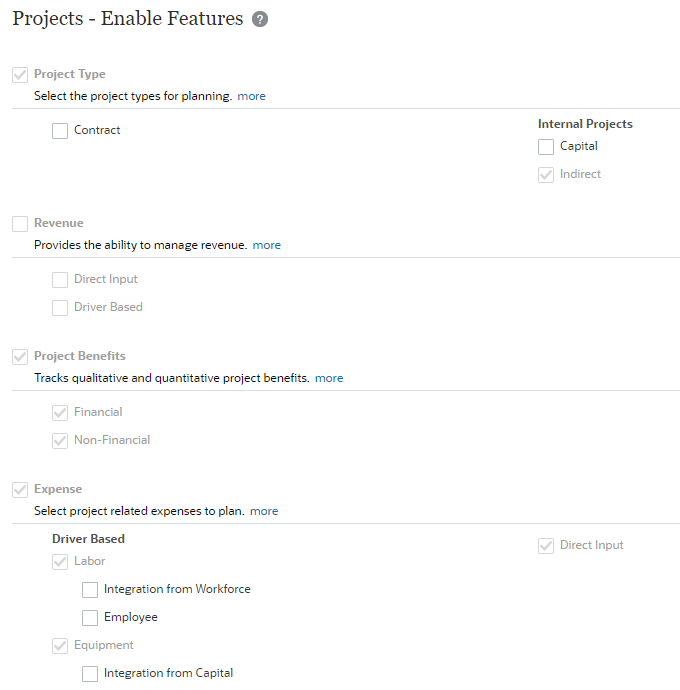
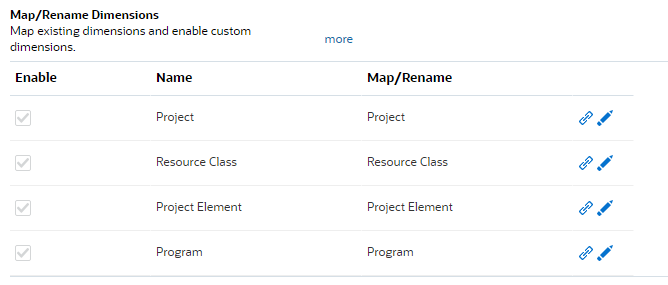
In this tutorial, you incrementally enable Contract project types and Revenue planning.
What Do You Need?
An EPM Cloud Service instance allows you to deploy and use one of the supported business processes. To deploy another business process, you must request another EPM Enterprise Cloud Service instance or remove the current business process.
- Have Service Administrator access to an EPM Enterprise Cloud Service instance. The instance should not have a business process created.
- Upload and import this snapshot into your instance.
Note:
If you run into migration errors importing the snapshot, re-run the migration excluding the HSS-Shared Services component, as well as the Security and User Preferences artifacts in the Core component. For more information on uploading and importing snapshots, refer to the Administering Migration for Oracle Enterprise Performance Management Cloud documentation.Reviewing User Variables
User Variables were added when the business process was created. User variables act as filters in forms, enabling planners to focus only on certain members. In this section, you review the values set for user variables.
- Click
 (Navigator), then under Tools, click User Preferences.
(Navigator), then under Tools, click User Preferences.

- On the left, click User Variables.
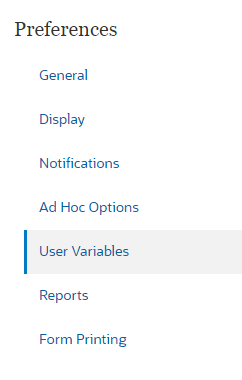
- Review the selected members for each dimension:
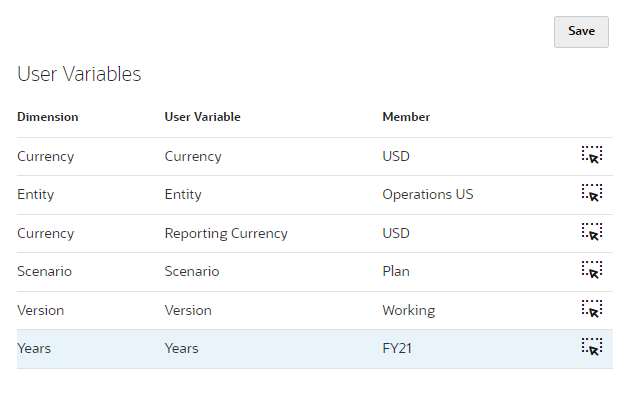
- Return to the home page. On the upper right, click
 (Home).
(Home).
Enabling Contract Projects and Revenue
In this section, you enable contract project types and revenue planning.
- On the home page, click Application, and then Configure.
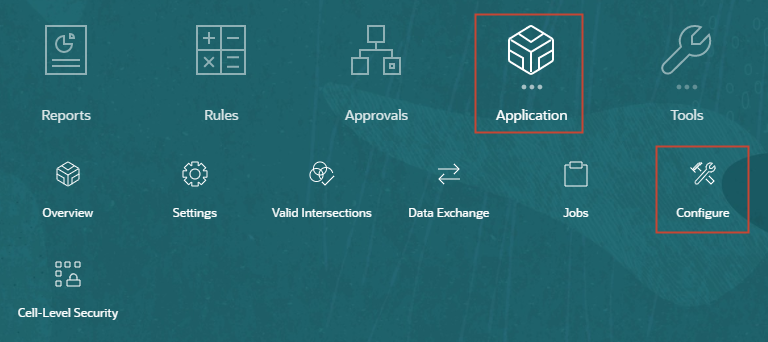
- On the Configure page, select Projects from the dropdown list.
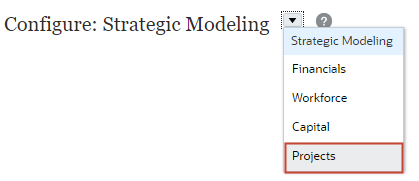
The Configure page for Projects is displayed.

- On the Configure page for Projects, click Enable Features.
- In Enable Features, under Project Type, select Contract.

A Contract project is work performed for a customer and the customer reimburses the company. A contract project generates revenue based on an underlying contract; costs are incurred and planned against it. The Contract project expenses, revenue, and billing can be for services performed and reimbursed by a client. Contract projects can be Time and Materials, Fixed Price, Cost Plus, and Other.
- Select Revenue, then Direct Input.
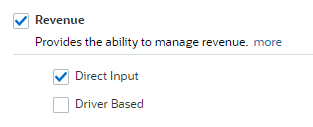
- On the upper-right, click Enable.
- At the confirmation message, click Yes.

The enable process takes a moment to complete.

- At the information message, click OK.

- Sign out and sign back into Planning.
- On the home page, click Projects and verify that Revenue is now available within that cluster.

Adding a Contract Project
In this section, you add a contract project.
- In the Projects cluster, click Project Summary.
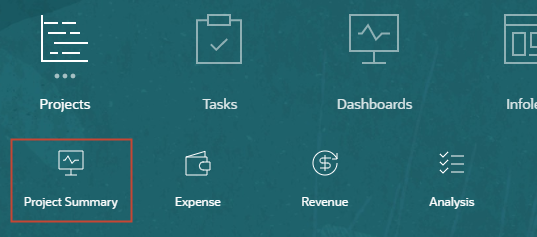
Project Summary opens with the Contract vertical tab selected and the Contract Projects Overview dashboard displayed.
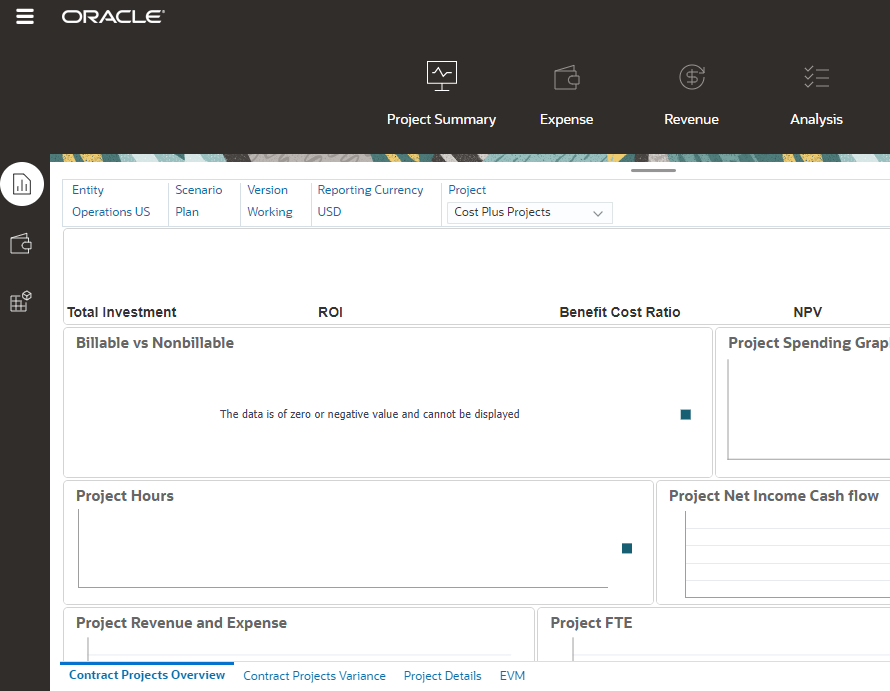
- From the horizontal tabs, click Project Details.
- In the grid's whitespace, right-click and select Add Project.
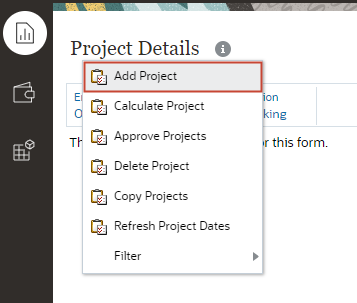
- In Add Project, enter or select the following:
Property Value Enter Project Name Eureka Enter Project Start Date 7/1/22 Enter Project End Date 3/1/24 - Verify your selections and click Next.
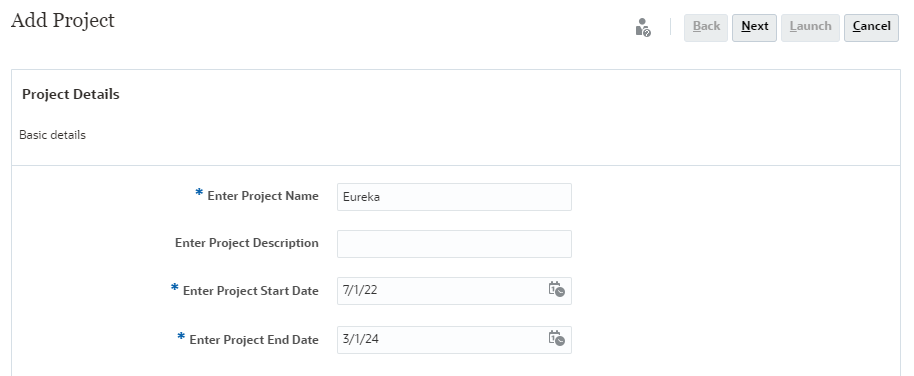
- For Contract project options, enter or select the following:
Property Value Enter Project Type Time and Material Enter Revenue Recognition Monthly Enter Revenue Cash Flow Same Month - Verify your selections and click Launch.

- At the information message, click OK.

The project was added and displays on the form.

Planning for Expenses
In this section, you enter expense assumptions and calculate expenses.
- From the cards on top, click Expense.

The Expense Overview dashboard is displayed.
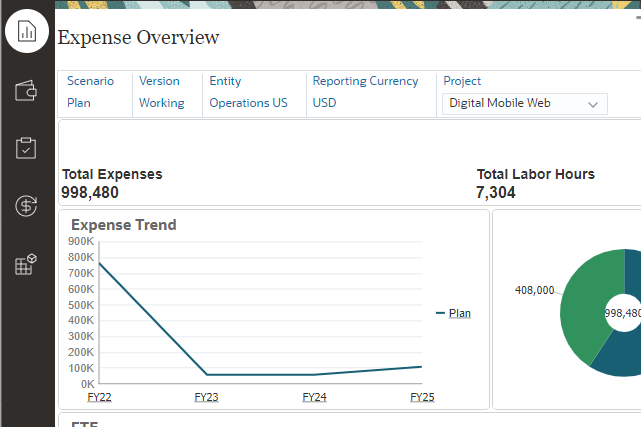
- In the POV, for Project, select Eureka and click
 (Go).
(Go).
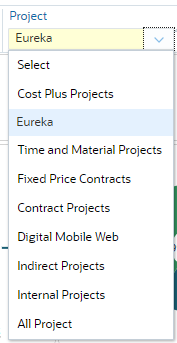
There is no data on the dashboard. You will be planning for expenses for the Eureka contract project.
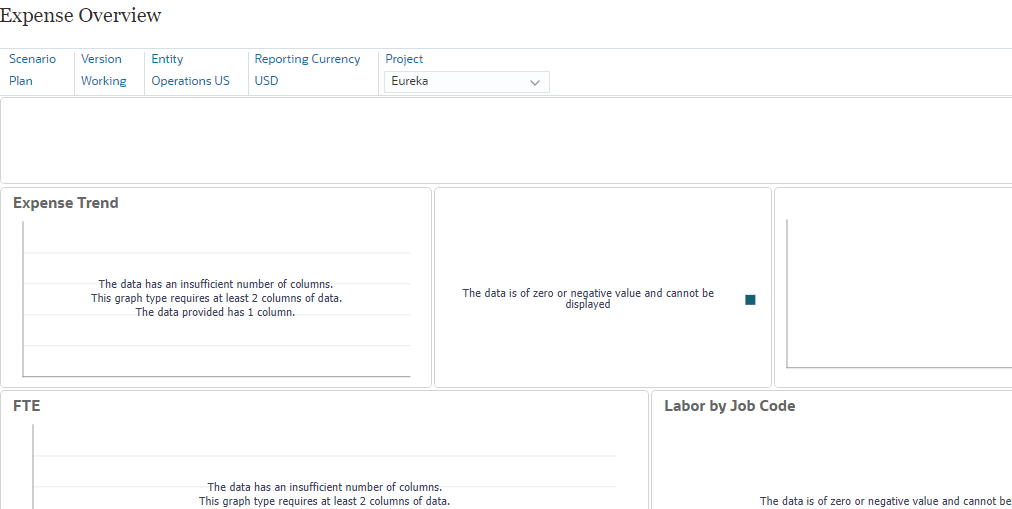
- From the vertical tabs on the left, click
 (Driver Based).
(Driver Based). - In Expense Assumptions for the Labor horizontal tab, verify that Eureka is selected in the Project POV.
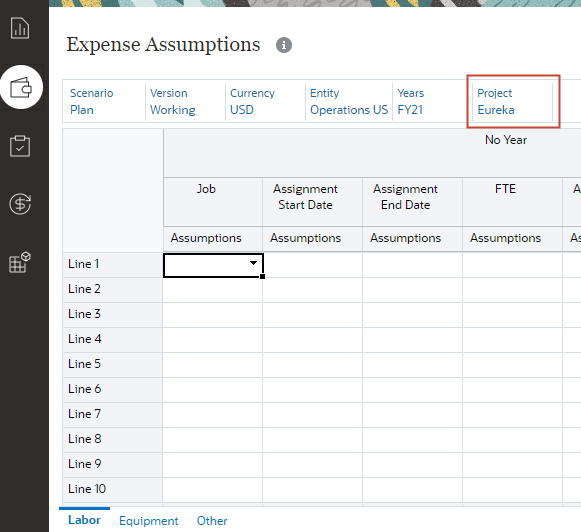
- In the grid, enter or select the following labor assignments:
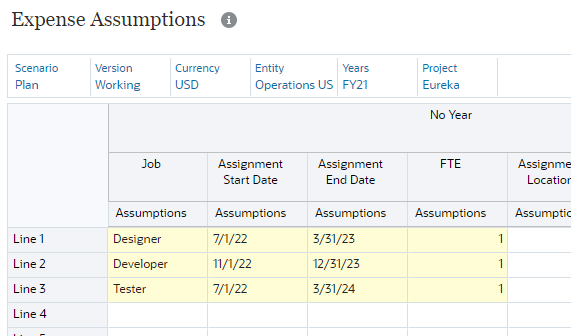
- Click Save.
- At the information message, click OK.
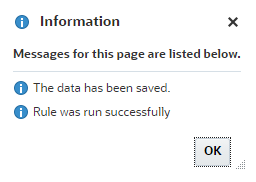
The background color of the "dirty" (yellow) cells turn white after data is saved.
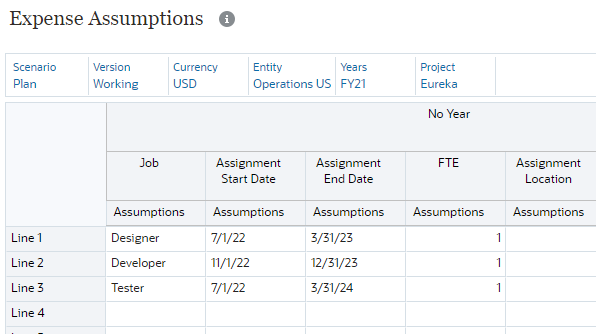
- In the grid's empty corner cell above Line 1, right-click and select Calculate Expenses.
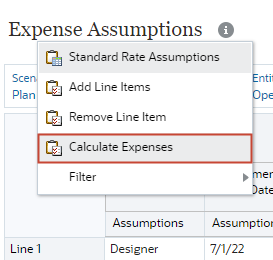
The calculation process takes a moment to complete.

- At the information message, click OK.
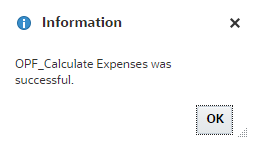
The form is updated with calculated data.

Planning for Revenue
In this section, you enter revenue directly to a project.
- From the cards on the top, click Revenue.

- In the Revenue Overview dashboard, verify that Eureka is selected in the Project POV.
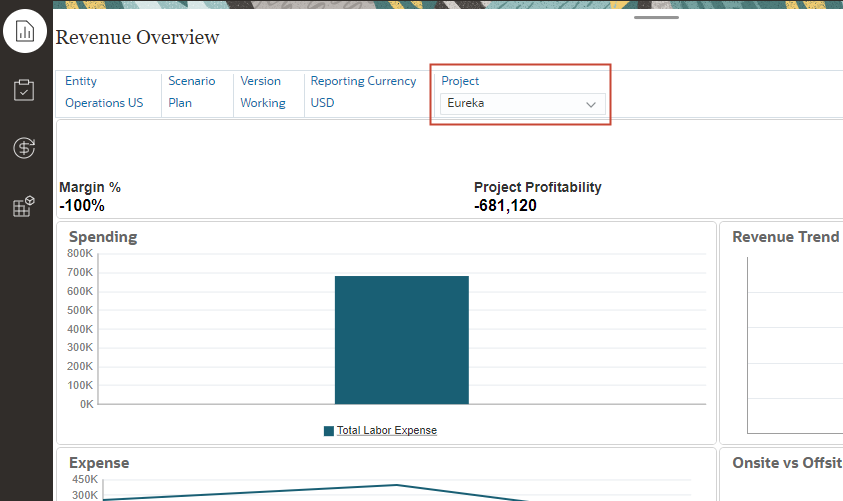
- From the vertical tabs on the left, click
 Direct Input.
Direct Input. - In Project Revenue, verify the POV selections.
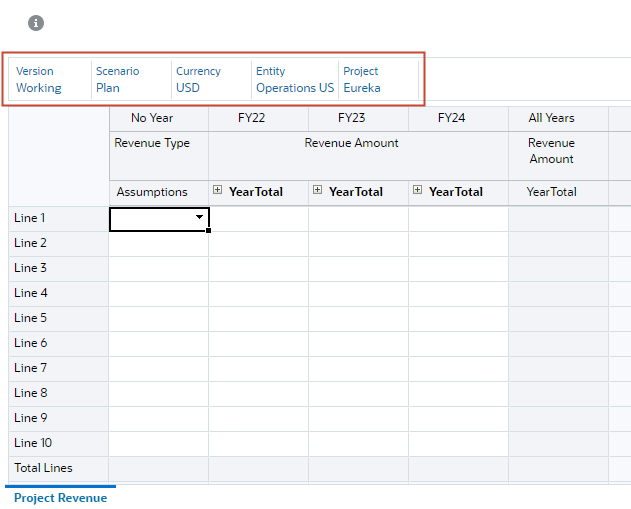
- In the grid, enter or select the following values:

- Click Save.
- At the information message, click OK.

The background color of the "dirty" (yellow) cells turn white after data is saved.
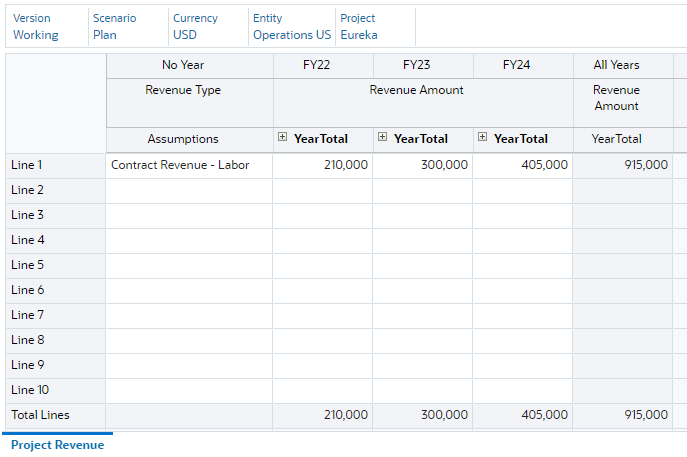
- In the grid's empty corner cell above Line 1, right-click and select Calculate Revenues.
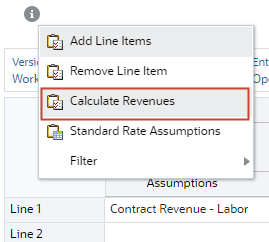
The calculation process takes a moment to complete.

- At the information message, click OK.
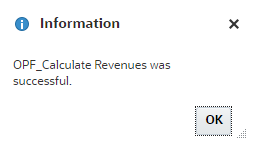
Data is saved, calculated, and aggregated.
Analyzing Contract Projects
In this section, you explore forms and dashboards used to review projects.
- From the cards on top, click Analysis.

- From the vertical tabs on the left, click
 (Profitability)
(Profitability) - Review the Project Detailed Analysis.

- From the horizontal tabs, click Project Profitability.
- Review Revenue and Expenses.
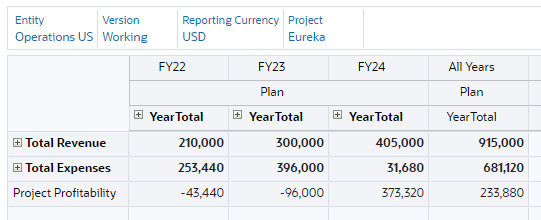
- Expand all levels under Total Revenue and Total Expenses and review the data on the form.
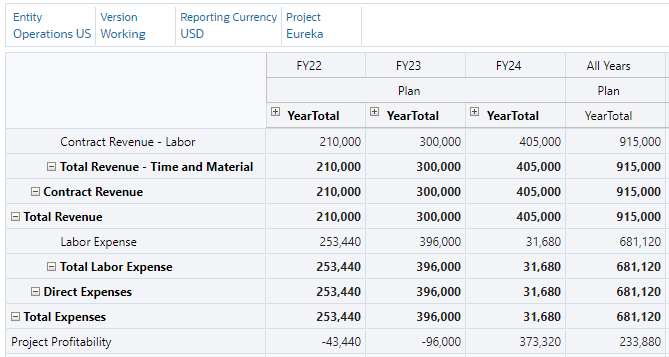
- Optional: Expand levels under YearTotal to review period distribution.
- From the cards on top, click Project Summary.

- From the vertical tabs on the left, verify that you are on
 (Contract).
(Contract). - From the horizontal tabs, click Contract Projects Overview.

- In Contract Projects Overview, verify the POV and review the dashboard.

Learn More
Incrementally Enabling Contract Projects and Revenue
F46721-02
April 2022
Copyright © 2022, Oracle and/or its affiliates.
This 35-minute tutorial shows you how to incrementally enable contract projects and revenue planning, plan for expenses, plan for revenue, and analyze plans.
This software and related documentation are provided under a license agreement containing restrictions on use and disclosure and are protected by intellectual property laws. Except as expressly permitted in your license agreement or allowed by law, you may not use, copy, reproduce, translate, broadcast, modify, license, transmit, distribute, exhibit, perform, publish, or display any part, in any form, or by any means. Reverse engineering, disassembly, or decompilation of this software, unless required by law for interoperability, is prohibited.
If this is software or related documentation that is delivered to the U.S. Government or anyone licensing it on behalf of the U.S. Government, then the following notice is applicable:
U.S. GOVERNMENT END USERS: Oracle programs (including any operating system, integrated software, any programs embedded, installed or activated on delivered hardware, and modifications of such programs) and Oracle computer documentation or other Oracle data delivered to or accessed by U.S. Government end users are "commercial computer software" or "commercial computer software documentation" pursuant to the applicable Federal Acquisition Regulation and agency-specific supplemental regulations. As such, the use, reproduction, duplication, release, display, disclosure, modification, preparation of derivative works, and/or adaptation of i) Oracle programs (including any operating system, integrated software, any programs embedded, installed or activated on delivered hardware, and modifications of such programs), ii) Oracle computer documentation and/or iii) other Oracle data, is subject to the rights and limitations specified in the license contained in the applicable contract. The terms governing the U.S. Government's use of Oracle cloud services are defined by the applicable contract for such services. No other rights are granted to the U.S. Government.
This software or hardware is developed for general use in a variety of information management applications. It is not developed or intended for use in any inherently dangerous applications, including applications that may create a risk of personal injury. If you use this software or hardware in dangerous applications, then you shall be responsible to take all appropriate fail-safe, backup, redundancy, and other measures to ensure its safe use. Oracle Corporation and its affiliates disclaim any liability for any damages caused by use of this software or hardware in dangerous applications.
Oracle and Java are registered trademarks of Oracle and/or its affiliates. Other names may be trademarks of their respective owners.
Intel and Intel Inside are trademarks or registered trademarks of Intel Corporation. All SPARC trademarks are used under license and are trademarks or registered trademarks of SPARC International, Inc. AMD, Epyc, and the AMD logo are trademarks or registered trademarks of Advanced Micro Devices. UNIX is a registered trademark of The Open Group.
This software or hardware and documentation may provide access to or information about content, products, and services from third parties. Oracle Corporation and its affiliates are not responsible for and expressly disclaim all warranties of any kind with respect to third-party content, products, and services unless otherwise set forth in an applicable agreement between you and Oracle. Oracle Corporation and its affiliates will not be responsible for any loss, costs, or damages incurred due to your access to or use of third-party content, products, or services, except as set forth in an applicable agreement between you and Oracle.